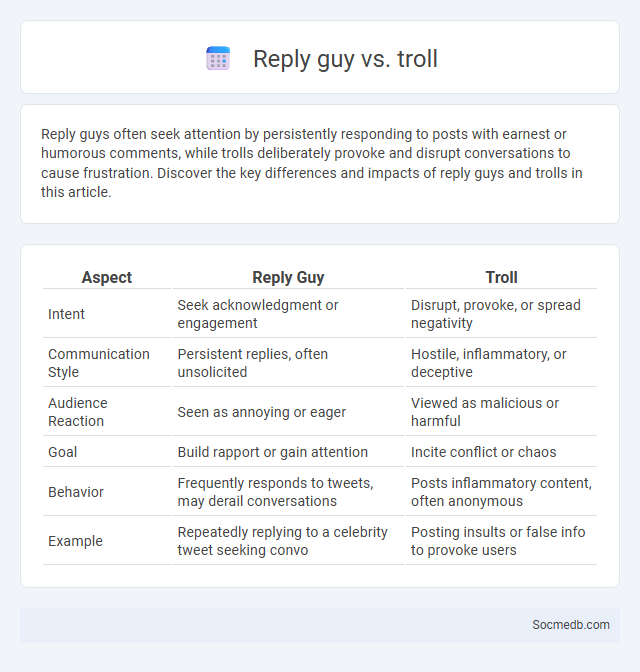
Photo illustration: Reply guy vs troll
Reply guys often seek attention by persistently responding to posts with earnest or humorous comments, while trolls deliberately provoke and disrupt conversations to cause frustration. Discover the key differences and impacts of reply guys and trolls in this article.
Table of Comparison
| Aspect | Reply Guy | Troll |
|---|---|---|
| Intent | Seek acknowledgment or engagement | Disrupt, provoke, or spread negativity |
| Communication Style | Persistent replies, often unsolicited | Hostile, inflammatory, or deceptive |
| Audience Reaction | Seen as annoying or eager | Viewed as malicious or harmful |
| Goal | Build rapport or gain attention | Incite conflict or chaos |
| Behavior | Frequently responds to tweets, may derail conversations | Posts inflammatory content, often anonymous |
| Example | Repeatedly replying to a celebrity tweet seeking convo | Posting insults or false info to provoke users |
Understanding the Digital Persona: Reply Guy vs Troll
Your digital persona on social media can significantly impact how others perceive your interactions, distinguishing a constructive Reply Guy--who thoughtfully engages and adds value--from a disruptive Troll intent on provoking and derailing conversations. Recognizing the behavioral patterns and intentions behind each role helps you navigate online spaces more effectively, fostering positive communication while avoiding unnecessary conflicts. Mastery of this distinction enhances your social media experience by promoting authentic connections and minimizing toxic interactions.
Defining the “Reply Guy” Phenomenon
The "Reply Guy" phenomenon on social media describes individuals who consistently respond to posts, often with unsolicited advice or excessive commentary, regardless of the original content's intent. These users typically seek attention, validation, or interaction by inserting themselves into conversations, sometimes irritating other participants. Understanding this behavior is crucial for managing online discourse and maintaining meaningful digital communication.
What Sets a Troll Apart from a Reply Guy?
A troll deliberately provokes and disrupts online conversations by posting inflammatory or off-topic messages to elicit emotional responses, while a reply guy typically responds persistently but constructively, often seeking engagement or validation. Trolls thrive on chaos and anonymity, using sarcasm or insults to derail discussions, whereas reply guys usually aim to contribute or correct, though sometimes excessively. Understanding this distinction helps you navigate social media interactions more effectively, identifying when to engage or disengage for a healthier online experience.
Behavioral Patterns: Reply Guys and Online Engagement
Reply guys exhibit distinct behavioral patterns by persistently responding to social media posts, often seeking attention or validation. Their consistent engagement influences online interaction dynamics, driving conversation threads and sometimes causing digital fatigue among original content creators. Understanding these patterns is crucial for analyzing user engagement metrics and developing strategies to foster healthier online communities.
Troll Tactics: Manipulation and Provocation Explained
Troll tactics on social media involve deliberate manipulation and provocation designed to elicit emotional responses and disrupt conversations. Common strategies include spreading misinformation, using inflammatory language, and exploiting polarization to amplify conflict within online communities. Understanding these methods is essential for identifying and mitigating the impact of trolls on platforms like Twitter, Facebook, and Instagram.
Common Motivations Behind Reply Guys and Trolls
Reply guys and trolls on social media often seek validation, attention, and a sense of control by provoking reactions from others. Their behavior is driven by underlying psychological needs such as insecurity, desire for social dominance, or frustration. Understanding these motivations helps in developing effective moderation strategies to maintain healthier online communities.
Social Impact: How Reply Guys and Trolls Affect Online Communities
Reply guys and trolls significantly disrupt online communities by spreading misinformation, escalating conflicts, and undermining constructive dialogue. Their behavior often leads to increased polarization, decreased trust, and a toxic atmosphere that drives away genuine participants. Effective moderation and community guidelines are crucial to mitigating their negative social impact and promoting healthier online interactions.
Recognizing the Warning Signs: Identifying Reply Guy vs Troll Behavior
Recognizing the warning signs between a reply guy and troll behavior involves analyzing engagement patterns and comment intent on social media platforms. Reply guys often exhibit persistent, unsolicited replies that aim to gain attention or validation, while trolls provoke conflict through inflammatory, off-topic, or aggressive comments designed to disrupt conversations. Understanding these distinctions enables users to maintain healthier online interactions and develop effective moderation strategies.
Dealing with Unwanted Interactions: Coping Strategies
Managing unwanted interactions on social media requires setting clear boundaries by blocking or muting users to protect Your mental health. Utilizing privacy settings and reporting abusive behavior to platform moderators helps create a safer online environment. Engaging in supportive communities and practicing mindful consumption reduces stress and promotes positive digital experiences.
Encouraging Healthy Online Discussions: Moving Beyond Reply Guy and Troll Dynamics
Encouraging healthy online discussions requires fostering respectful communication and promoting digital literacy to move beyond disruptive Reply Guy and troll dynamics. Platforms can implement robust moderation tools and community guidelines that prioritize constructive dialogue and minimize harassment or inflammatory behavior. Empowering users to engage thoughtfully enhances the quality of conversations and builds supportive online communities.
 socmedb.com
socmedb.com